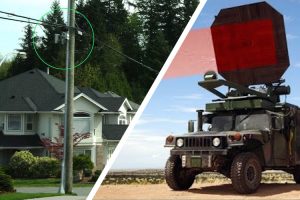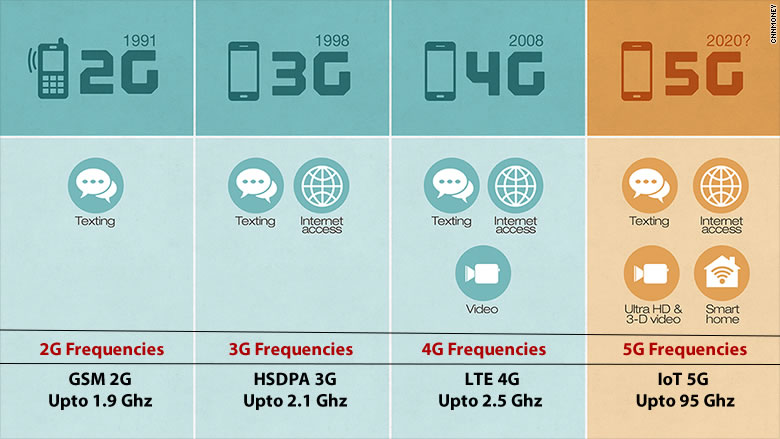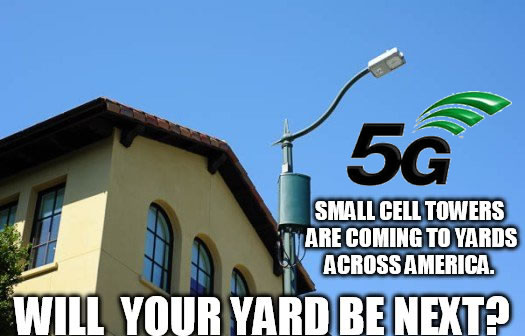Today’s cellular and Wi-Fi networks rely on microwaves – a type of electromagnetic radiation utilizing frequencies up to 6 gigahertz (GHz) in order high-speed wireless transmission of voice and data. Today’s era of wireless frequency is almost over; making room for new 5 G applications will require using new spectrum bands in much higher frequency ranges above 6 GHz to 100 GHz and beyond, utilizing submillimeter and millimeter waves.
5G is the fifth-generation technology for cellular networks, designed to deliver fast speeds, low latency, high capacity, and greater reliability. 5G operates across different frequency bands within the radio spectrum, which ranges from 3 kHz to 300 GHz. The 5G frequency bands are divided into three layers: Low-Band, Mid-Band, and High-Band (also known as millimeter wave). Low-Band 5G operates in the frequency range of 600 MHz to 1 GHz, providing greater range and slightly faster speeds than 4G. Mid-Band 5G spans from 1 GHz to 6 GHz, offering a balance between speed and range, and is ideal for high-demand suburbs and cities. High-Band 5G operates in the frequency range of 24 to 39 GHz and provides the fastest speeds and lowest latency, but with limited range and difficulty penetrating obstacles.
Introduction
5G, the fifth-generation technology for cellular networks, has created a buzz in the tech world. With its promising speeds, low latency, massive capacity, and greater reliability, 5G has the potential to replace traditional broadband internet and transform various industries. 5G operates across different frequency bands, allowing it to cater to different applications. In this article, we will delve into 5G frequency bands, including the 5G spectrum and the three layers of 5G frequencies: Low-Band, Mid-Band, and High-Band (also known as mmWave).
Low-Band 5G
Low-Band 5G is also referred to as “Nationwide 5G” by Verizon and “Extended Range 5G” by T-Mobile. This frequency band ranges from 600 MHz to 1 GHz and in some cases up to 2.3 GHz. Since it’s on the lower end of the 5G spectrum, Low-Band 5G frequencies have greater range and are not as easily affected by obstacles. The speed may be slightly faster than 4G at times, although the difference is not noticeable for most people. To coexist with 4G frequencies, Low-Band 5G uses Dynamic Spectrum Sharing (DSS) technology, which allocates bandwidth between 4G and 5G based on demand. As more people upgrade to 5G devices, 5G traffic will improve its performance.
Mid-Band 5G
Mid-Band 5G spans from 1 GHz to 6 GHz, with the majority being in the 2.4 GHz to 4 GHz range, including the famous C-Band (3.7 to 3.98 GHz). Mid-Band 5G offers a balance between speed, range, penetration, and capacity, providing fast speeds that range from 300 Mbps to 1 Gbps. This frequency band can cover large areas and is ideal for widespread 5G deployments.
High-Band (mmWave)
High-Band (mmWave) is the top layer of 5G frequencies, starting at 24 GHz. This frequency band offers the fastest speeds, with some reports of reaching up to 10 Gbps. However, it has a shorter range and is easily obstructed by obstacles such as buildings and trees. High-Band (mmWave) is best suited for high-density areas, like densely populated cities and sports stadiums.
Conclusion
5G frequency bands are crucial to the functioning of 5G technology. Understanding the different frequency bands and their capabilities is crucial for choosing the right 5G network for your needs. Low-Band 5G offers greater range, Mid-Band 5G offers a balance between speed and range, and High-Band (mmWave) offers the fastest speeds but with a shorter range. Whether you are in a high-density area or a rural location, 5G has a frequency band that can cater to your needs.
FAQs
- What is 5G? 5G is the fifth-generation technology for cellular networks, promising to deliver fast speeds, low latency, massive capacity, and greater reliability. It has the potential to replace traditional broadband internet and transform various industries.
- What are 5G frequency bands? 5G frequency bands are the frequencies within the radio spectrum allocated for 5G. 5G devices and 5G towers communicate wirelessly via radio waves, which are tuned to specific frequencies within the 5G spectrum.
- What is the 5G spectrum? The 5G spectrum is divided between the Sub-6 GHz range (frequencies below 6 GHz) and mmWave range (starting at 24 GHz). The 5G spectrum is made up of three layers: Low-Band, Mid-Band, and High-Band
| Carrier | Low-Band 5G Freq | Mid-Band 5G Freq | High-Band 5G Freq |
|---|---|---|---|
| AT&T 5G | 850 MHz: Band n5 | 3.4 GHz: Band n2 3.7 GHz: Band n77 | 24 GHz: Band n258 28 GHz: Band n261 39 GHz: Band n260 |
| Verizon Wireless 5G | 850 MHz: Band n5 1700/2100 MHz: Band n66 1900 MHz: Band n2 | 3.7 GHz: Band n77 | 28 GHz: Band n261 39 GHz: Band n260 |
| T-Mobile 5G | 600 MHz: Band n71 2.5 GHz: Band n41 3.4 GHz: Band n2 3.7 GHz: Band n77 | 24 GHz: Band n258 28 GHz: Band n261 39 GHz: Band n260 47 GHz: Band n262 (Pending) | |
| U.S. Cellular 5G | 600 MHz: Band n71 3.4 GHz: Band n77 3.7 GHz: Band n77 | 24 GHz: Band n258 28 GHz: Band n261 39 GHz: Band n260 | |
| Cricket Wireless 5G | 850 MHz: Band n5 | 3.7 GHz: Band n77 | 39 GHz: Band n260 |
| Boost Mobile 5G | N/A | 2.5 GHz: Band n41 | N/A |
| Metro by T-Mobile 5G | 600 MHz: Band n71 | N/A | 28 GHz: Band n261 39 GHz: Band n260 |
More Uses Of Millimeter Waves
Active Denial Technology is a non-lethal directed energy weapon that uses radio frequency millimeter waves at 95 gigahertz to produce an intolerable heating sensation in a targeted individual. The sensation is produced by a beam that penetrates the skin to a depth of 1/64th of an inch. The weapon has been used for crowd control, patrol and convoy protection, perimeter security and other defensive and offensive operations. The system has been tested on over 13,000 volunteer subjects and there is a 1/10th of 1% chance of injury from exposure. The technology is available in two system configurations, System 1 and System 2, and there are efforts underway to identify new millimeter-wave sources for smaller-scale and more mobile versions of the system.
Introduction to Non-Lethal Directed Energy Weapons using Radio Frequency Millimeter Waves
Directed energy weapons, using radio frequency millimeter waves, have been developed as a non-lethal means of crowd control, patrol and convoy protection, perimeter security and other defensive and offensive operations. These weapons use millimeter waves at a frequency of 95 gigahertz to penetrate the skin to a depth of about 1/64th of an inch, producing an intolerable heating sensation that compels the targeted individual to move, thereby achieving the desired effect. This technology has been developed by the Joint Non-Lethal Weapons Program and has been successfully integrated into two system configurations: System 1 and System 2.
History of Active Denial Technology
Active Denial Technology, the technology behind these non-lethal directed energy weapons, was developed by the Joint Non-Lethal Weapons Program. From 2002 to 2007, the Active Denial System Advanced Concept Technology Demonstration integrated and packaged Active Denial Technology into two system configurations. System 1, the technology prototype, was integrated into a High Mobility Multi-Purpose Wheeled Vehicle, while System 2 was built as an armored, containerized system that was transportable by tactical vehicles. Both systems completed a series of land and maritime-based military utility assessments and have been available for Service or Combatant Command exercises, as well as suitable for operational employment.
Current Configurations of Active Denial System
System 1 has been refurbished into a more robust and mobile system transported by a Marine Corps Medium Tactical Vehicle Replacement truck, while System 2 remains an armored, containerized system transportable by tactical vehicles. Both prototypes are long-range, large spot size systems, suitable for operational employment.
Human Effects of Active Denial Technology
Human effects testing on the large-scale version of Active Denial Technology has included more than 13,000 exposures on volunteer subjects, both in static demonstrations and in realistic operational assessments. Both laboratory research and full-scale test results have demonstrated that there is only a 1/10th of 1% chance of injury from a System 1 or System 2 exposure. The safety and effectiveness of 95 gigahertz millimeter-wave directed energy has been peer-reviewed in numerous professional journals and independently reviewed by the Human Effects Advisory Panel.
Technology Demonstrations
The Joint Non-Lethal Weapons Program has had a proactive strategy in raising awareness of the benefits, safety, and effectiveness of this new technology. Several major broadcast and print media reporters have attended technology demonstrations, providing firsthand accounts of the effects of System 1 or 2. The technology has been featured on CBS’s 60 Minutes, the Discovery Channel’s Future Weapons program, and the History Channel’s Modern Marvels program.
ADS Conclusion
In conclusion, non-lethal directed energy weapons using radio frequency millimeter waves have been developed as a safe and effective means of crowd control, patrol and convoy protection, perimeter security, and other defensive and offensive operations. These weapons have been successfully integrated into two system configurations, System 1 and System 2, which have been tested and demonstrated to be safe and effective.
FAQs
- What is the frequency of millimeter waves used in non-lethal directed energy weapons? The frequency of millimeter waves used in non-lethal directed energy weapons is 95 gigahertz.
- How does the directed energy from these weapons penetrate the skin? The directed energy from these weapons penetrates the skin to a depth of about 1/64th of an inch,
 Millimetre waves are utilized by the U.S. Army in crowd dispersal guns called Active Denial Systems. Dr. Paul Ben-Ishai pointed to research that was commissioned by the U.S. Army to find out why people ran away when the beam touched them. “If you are unlucky enough to be standing there when it hits you, you will feel like your body is on fire.” The U.S. Department of Defense explains how: “The sensation dissipates when the target moves out of the beam. The sensation is intense enough to cause a nearly instantaneous reflex action of the target to flee the beam.”
Millimetre waves are utilized by the U.S. Army in crowd dispersal guns called Active Denial Systems. Dr. Paul Ben-Ishai pointed to research that was commissioned by the U.S. Army to find out why people ran away when the beam touched them. “If you are unlucky enough to be standing there when it hits you, you will feel like your body is on fire.” The U.S. Department of Defense explains how: “The sensation dissipates when the target moves out of the beam. The sensation is intense enough to cause a nearly instantaneous reflex action of the target to flee the beam.”
It uses radio frequency millimeter waves in the 96GHz range to penetrate the top 1/64 of an inch layer of skin on the targeted individual, instantly producing an intolerable heating sensation that causes them to flee.
A lot of respected people have posted warnings about the mass deployment of commercial millimeter-wave technology.
Do Millimeter Waves Pose A Health Risk?
Devra Lee Davis – Founding Director of the Board on Environmental Studies and Toxicology of the U.S. National Research Council, National Academy of Sciences, Founding Director of the Center for Environmental Oncology, University of Pittsburgh Cancer Institute, who has taught at the University of California, San Francisco and Berkeley, Dartmouth, Georgetown, Harvard, London School of Hygiene and Tropical Medicine and other major universities, and has had articles published in Lancet, Journal of the American Medical Association to Scientific American, the New York Times and elsewhere – says that the 5G wavelengths used in IoT have never been tested for health effects, and may adversely impact our skin and sweat glands:
5G networks will support the coexistence of multiple standards (e.g., LTE, WiFi) and coordinate with various site types (macro, micro, and pico base stations). A premier challenge of 5G network design has been to create a network architecture capable of supporting this kind of flexibility while meeting the multifaceted access demands of an Internet of Things (IoT) future.

The new 5G networks will also need to incorporate seamless coexistence of 4G and 5G standards. The transitions from 2G to 3G and 3G to 4G involved completely separate networks, but 4G will remain in force for the foreseeable future—more than that, 4G infrastructure is critical to the evolution and functionality of the 5G network.
Many new Smartphones are 5G ready now, and will only require a software update to start transmitting in 5G frequencies.
5G networks have divided network services into three categories: enhanced Mobile Broadband (eMBB) or handsets; Ultra-Reliable Low-Latency Communications (URLLC), which includes industrial applications and autonomous vehicles; and Massive Machine Type Communications (MMTC) or sensors. Initial 5G deployments will focus on eMBB and fixed wireless, which makes use of many of the same capabilities as eMBB. 5G will use spectrum in the existing LTE frequency range (600 MHz to 6 GHz) and also in millimeter wave bands (24–86 GHz). 5G technologies have to satisfy ITU IMT-2020 requirements and/or 3GPP Release 15; while IMT-2020 specifies data rates of 20 Gbit/s, 5G speed in sub-6 GHz bands is similar to 4G.








